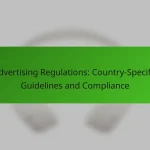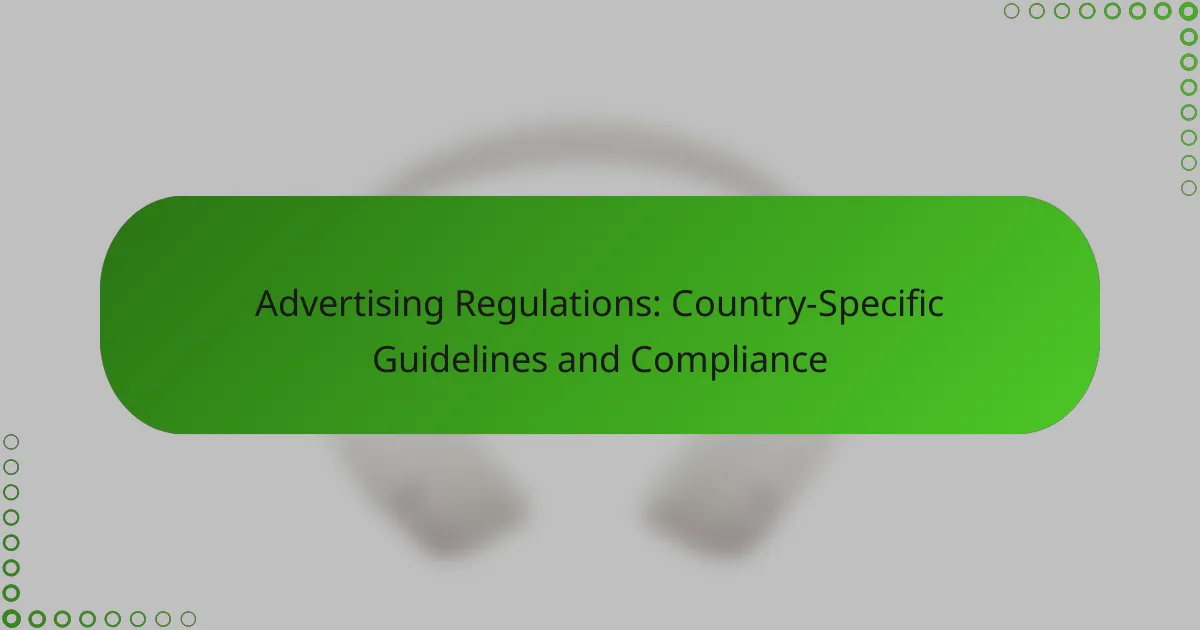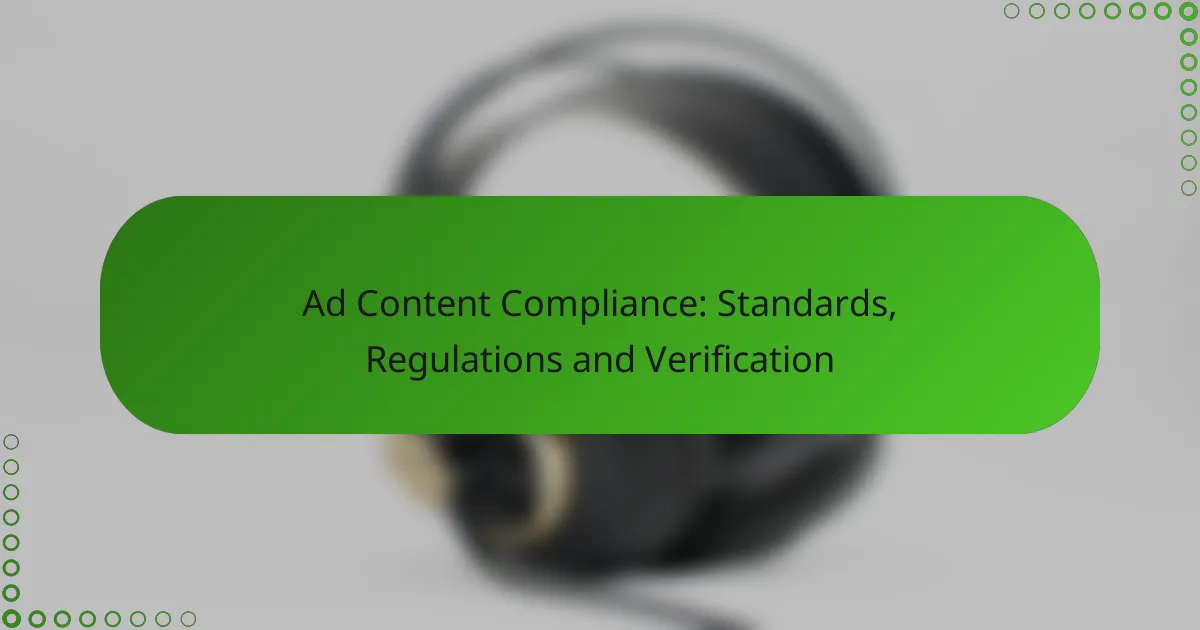Display advertising compliance is crucial for maintaining legal standards and consumer trust. Common pitfalls such as misleading content and inadequate data privacy can lead to significant repercussions for advertisers. By implementing clear guidelines, conducting regular audits, and prioritizing transparency, businesses can navigate these challenges effectively and enhance their advertising success.

What are the common pitfalls in display advertising compliance?
Common pitfalls in display advertising compliance include misleading ad content, inadequate data privacy measures, and failure to adhere to platform policies. These issues can lead to legal repercussions, loss of consumer trust, and reduced ad effectiveness.
Misleading ad content
Misleading ad content occurs when advertisements present false or exaggerated claims about a product or service. This can mislead consumers and violate advertising standards, leading to penalties or reputational damage.
To avoid this pitfall, ensure that all claims are substantiated and clearly presented. Use straightforward language and avoid ambiguous terms that could confuse consumers.
Inadequate data privacy measures
Inadequate data privacy measures can expose businesses to legal risks and consumer backlash. Advertisers must comply with regulations like GDPR in Europe or CCPA in California, which mandate transparency in data collection and usage.
Implement strong data protection practices, such as obtaining explicit consent from users and providing clear privacy policies. Regularly review and update these measures to stay compliant with evolving regulations.
Failure to adhere to platform policies
Each advertising platform has specific policies that must be followed to maintain compliance. Failing to adhere to these can result in ad disapproval or account suspension.
Regularly review the advertising guidelines of platforms like Google Ads or Facebook Ads. Create a checklist to ensure all ads meet the required standards before submission.
Ignoring regional regulations
Ignoring regional regulations can lead to significant legal issues, as advertising laws vary widely across different jurisdictions. Advertisers must be aware of local laws regarding advertising content, data protection, and consumer rights.
Research the specific regulations in each region where you plan to advertise. Consider consulting with legal experts to ensure compliance and avoid costly fines.
Lack of transparency in targeting
A lack of transparency in targeting can erode consumer trust and lead to accusations of discrimination. Advertisers should clearly communicate how and why they target specific audiences.
Use clear language to explain targeting criteria in your privacy policy. Additionally, provide users with options to opt out of targeted advertising to enhance transparency and foster trust.

How can advertisers ensure compliance in display advertising?
Advertisers can ensure compliance in display advertising by establishing clear guidelines, conducting regular audits, utilizing compliance software, and providing staff training on relevant regulations. These strategies help mitigate risks associated with non-compliance and foster a culture of accountability.
Implementing clear guidelines
Clear guidelines are essential for maintaining compliance in display advertising. These guidelines should outline acceptable practices, including content restrictions, targeting criteria, and data privacy measures. For instance, advertisers should specify which types of claims are permissible and ensure that all creatives adhere to legal standards.
To create effective guidelines, involve key stakeholders such as legal, marketing, and compliance teams. Regularly review and update these guidelines to reflect changes in regulations and industry standards, ensuring that all team members are aware of their responsibilities.
Regular compliance audits
Conducting regular compliance audits is crucial for identifying potential issues in display advertising campaigns. These audits should assess whether advertisements meet established guidelines and comply with applicable laws. Aim to perform audits quarterly or biannually to stay ahead of any compliance challenges.
During an audit, evaluate various aspects such as ad content, targeting practices, and data handling procedures. Document findings and implement corrective actions promptly to address any identified shortcomings, reducing the risk of penalties or reputational damage.
Utilizing compliance software
Compliance software can streamline the process of ensuring adherence to advertising regulations. These tools often include features like automated checks for legal compliance, reporting capabilities, and tracking of changes in regulations. By integrating compliance software into your workflow, you can enhance efficiency and accuracy.
When selecting compliance software, consider factors such as ease of use, integration with existing systems, and the ability to customize compliance checks based on your specific needs. This investment can save time and resources while minimizing the risk of non-compliance.
Training staff on regulations
Training staff on advertising regulations is vital for fostering a compliant culture within your organization. Regular training sessions should cover key regulations, company guidelines, and best practices for display advertising. This ensures that all team members understand their roles in maintaining compliance.
Consider implementing a mix of training formats, such as workshops, online courses, and refreshers on recent regulatory changes. Encourage open discussions about compliance challenges and share case studies to illustrate the importance of adhering to regulations in display advertising.

What are the best practices for display advertising compliance?
Best practices for display advertising compliance focus on adhering to legal standards, ensuring transparency, and maintaining user trust. Implementing these practices can help avoid legal pitfalls and enhance the effectiveness of advertising campaigns.
Adhering to GDPR standards
Adhering to GDPR standards is crucial for businesses operating in or targeting customers in the European Union. This regulation mandates that personal data must be collected and processed lawfully, transparently, and for specific purposes. Companies should ensure they have a clear privacy policy and obtain explicit consent from users before collecting their data.
To comply, businesses can implement data protection measures such as data minimization and regular audits of data processing activities. Failure to comply can result in significant fines, often reaching up to 4% of annual global turnover.
Using clear opt-in mechanisms
Using clear opt-in mechanisms is essential for gaining user consent in display advertising. This involves providing users with straightforward options to agree to data collection and processing. Opt-in forms should be easy to understand and accessible, ensuring users know what they are consenting to.
Best practices include using checkboxes that are not pre-checked and providing detailed information about how user data will be used. This transparency builds trust and can lead to higher engagement rates with ads.
Maintaining accurate ad disclosures
Maintaining accurate ad disclosures is vital for compliance and user trust. Advertisers must clearly label sponsored content and disclose any material connections with brands. This helps users understand the nature of the content they are viewing and prevents misleading practices.
For example, using phrases like “Sponsored” or “Ad” at the beginning of a post can clarify the relationship between the advertiser and the content. Regularly reviewing and updating disclosures ensures ongoing compliance with advertising standards.
Conducting A/B testing for compliance
Conducting A/B testing for compliance can help advertisers identify the most effective and compliant strategies for their display ads. This involves comparing two versions of an ad to see which one performs better while adhering to legal standards. Testing can reveal insights into user preferences and compliance pitfalls.
When conducting A/B tests, ensure that both versions meet compliance requirements, such as clear disclosures and consent mechanisms. This approach not only optimizes ad performance but also reinforces adherence to regulations, minimizing the risk of non-compliance issues.

What frameworks help in assessing compliance risks?
Frameworks for assessing compliance risks in display advertising include structured tools like compliance checklists and risk assessment matrices. These frameworks help organizations identify potential pitfalls and ensure adherence to relevant regulations and standards.
Compliance checklists
Compliance checklists are practical tools that outline specific requirements and best practices for display advertising. They typically include items such as verifying ad content, ensuring proper targeting, and confirming adherence to privacy regulations.
To create an effective checklist, consider including key elements like data protection measures, consent management, and transparency in advertising practices. Regularly updating the checklist to reflect changes in regulations is crucial to maintaining compliance.
Risk assessment matrices
Risk assessment matrices provide a visual representation of potential compliance risks associated with display advertising. These matrices typically categorize risks based on their likelihood and potential impact, helping organizations prioritize their compliance efforts.
When developing a risk assessment matrix, consider factors such as the nature of the advertising content, the target audience, and applicable regulations. Regularly reviewing and adjusting the matrix can help organizations stay ahead of emerging risks and ensure ongoing compliance.

How do regional regulations affect display advertising compliance?
Regional regulations significantly shape display advertising compliance by imposing specific legal requirements that advertisers must follow. These regulations vary by location and can affect data privacy, consent management, and advertising content standards.
Understanding CCPA in California
The California Consumer Privacy Act (CCPA) requires businesses to inform consumers about the personal data collected and how it is used. Advertisers must provide clear options for consumers to opt-out of data selling and ensure transparency in their data practices.
To comply with CCPA, businesses should implement a straightforward privacy policy that outlines data collection methods and consumer rights. Regular audits of data practices can help identify potential compliance issues before they arise.
Adapting to EU GDPR requirements
The General Data Protection Regulation (GDPR) mandates strict guidelines for data processing and privacy in the European Union. Advertisers must obtain explicit consent from users before collecting personal data and provide clear information about data usage.
To align with GDPR, companies should develop comprehensive consent management systems that allow users to easily grant or withdraw consent. Additionally, maintaining detailed records of consent and data processing activities is crucial for compliance.

What tools assist in ensuring compliance?
Several tools can help ensure compliance in display advertising, focusing on data privacy, ad content, and regulatory adherence. These tools streamline processes, reduce risks, and enhance transparency in advertising practices.
OneTrust for data privacy
OneTrust is a leading platform designed to help businesses manage data privacy compliance effectively. It offers features that assist in tracking user consent, managing data subject requests, and ensuring adherence to regulations like GDPR and CCPA.
Using OneTrust, companies can automate compliance workflows, which reduces the risk of human error and improves efficiency. For instance, it can help businesses maintain records of consent and provide users with easy access to their data preferences.
To maximize the benefits of OneTrust, organizations should regularly update their privacy policies and conduct audits to ensure all data practices align with current regulations. This proactive approach can prevent costly fines and enhance consumer trust.









